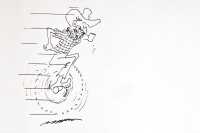A dark story about death, love and loss
Dear readers, if you decide to purchase this amazing novel, please consider the following advice: forget George Romero and the multitudes of lurching zombies that have become common fare in both films and novels. Purge your mind of ravenous, decaying flesh-eaters who crawl and stagger through cemeteries, suburban housing projects and shopping malls.
John Ajvide Lindqvist has re-invented the concept of the undead (just as he re-invented the traditional image of the vampire in Let the Right One In). His “undead” are more docile, but frightening nevertheless.
Lindqvist’s tale begins with a breakdown in utilities service in Stockholm. During a heat wave, electrical appliances begin to malfunction. Televisions, vacuum cleaners and electric stoves can’t be shut off. In addition, the entire populace seems to be suffering from migraines and tempers are short. Then, the inconceivable happens: all of the dead in the local morgue get up and walk. Those that manage to escape before the police arrive (trailing sheets and revealing their autopsy stitches) begin a slow trek through the city, and many are giving a piteous cry: “Home! Home!”
David Zetterburg, a popular local comedian, finds his life turning into nightmare when his beautiful and gifted wife is killed in an automobile accident. Called to the hospital to identify Eva, he arrives in time to witness his wife’s “reanimation.” Despite extensive, fatal injuries to her face and body, Eva’s corpse stirs, sits up and looks at her husband.
Elvy Lundberg had dutifully tended her husband, Tore, in his final illness. After his death, she tries to put her life together again and find peace with her granddaughter with whom she shares a kind of telepathy and “second sight.” Then, Tore, who has been dead for over a month, comes home.
Then, there is Gustav Mahler (He takes a lot of kidding about that name). He is an overweight journalist with a pacemaker and his life evolves around his new grandson, Elias. When the child is killed (he falls from the window of his parent’s apartment) Mahler is devastated. However, Gustav hears that the dead are awakening all over Stockholm, and he wonders about his grandson’s lonely grave. Although Elias has been buried for two months, Gustav unearths the coffin with his bare hands and brings Elias home ... if, indeed, the creature in the coffin is Elias.
Related Items
Eventually, Stockholm’s hospital personnel, in conjunction with the police and the military, round up the dead who have now been christened the “reliving.” Totally at a loss as to what to do, the authorities confine the dead in the local hospital. The military dispatches special forces who are instructed to disinter all of the dead who have died recently (those who have died more than four months ago do not “awaken”) and a governmental announcement instructs the public to turn in their deceased relatives who return home.
Handling the Dead is not a horror novel in any traditional sense. Instead, Lindqvist uses the folklore of the undead to develop a disturbing meditation on the nature of death, love and loss. Moving back and forth among his major characters, the author tells a dark, suspenseful story.
David wishes to bring his “reliving” wife home, but her behavior becomes increasingly strange. Elvy sees a vision and is convinced that the world is on the brink of Apocalypse. Eventually, she begins to preach to her neighbors, citing the biblical passage about the dead rising from their graves. Flora, Elvy’s granddaughter takes up residence in a half-completed housing complex called Heath, which is also inhabited by a large group of young dissidents. Gustav flees with his daughter and Elias to a remote cabin where he plans to rehabilitate his grandson.
Study of the newly-awakened dead by medical and psychological specialists reveals bizarre facts. When large groups of living people visit or attempt to converse with the “reliving,” they discover that they (the visitors) can read each other’s minds. The experience proves to be disorienting since they are hearing hundreds of voices and can no longer recognize their own thoughts. In addition, the awakened dead are incapable of individual thought and only mimic the wishes (spoken and unspoken) of those around them. Much of the time they appear docile; however, they become angry or frustrated if these emotions are exhibited by those around them. The only objects that interest are wind-up toys.
Eventually, all of the awakened dead are transported to the Heath, with plans to develop it into a rehabilitation center. This move and the subsequent visits by relatives and the public proves to be disastrous. Belatedly, all of the relatives of the “reliving” realize that the beings that have returned bear no resemblance to their loved ones.
David’s wife, Eva, once a gifted writer of children’s books, does not know her husband or her child. Although she can speak (which is rare among the “reliving”), she merely repeats variations of statements others make to her. When Gustav attempts to rehabilitate his grandson, Elias becomes violent and attacks him — a response that is prompted by the anger and frustration that Gustav is experiencing because his rehabilitative therapy is failing.
As all attempts by the authorities fail, the “reliving” are abandoned. Helpless and without defenses, they are attacked and killed by bands of marauding citizens who find them participating in a solemn dance outside the Heath. When Handling the Dead draws to an end, the fate of the “reliving” is uncertain. Perhaps, lie the disenfranchised aliens in “District 9,” they will end up living on government subsidies. Another possibility is Elvy, who comes to believe that she had misinterpreted her vision. Instead of saving the living, Elvy believes that she was meant to save the awakened dead. Now she wants to help them return home. Apparently, “home” is a second death.
Excluding the violence at the end of this novel (a bonfire of the “reliving” who all die a second time and a “zombie from the sea that acts like the undead in a Romero flick), Handling the Dead has no scenes of mass carnage. Instead, Lindqvist depicts a psychological horror which arises from the realization that nothing is beyond the grave except silence. In essence, that is the message that reawakened dead deliver. Although the novel ends with a reaffirming symbol — a white caterpillar that becomes a butterfly — it does little to erase Lindqyist’s images of what lies beyond the grave: a devastating silence.
Handling the Dead by John Ajvide Lindqvist. Quercus Publishing. 364 pages









